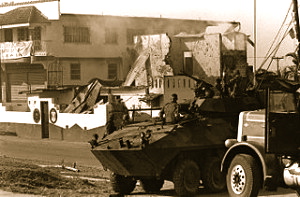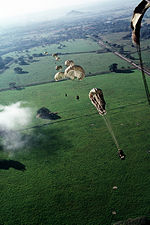Panama War

First Person Account of The Invasion of Panama 1989

Media Burn Founder Tom Weinberg introduces a piece on Videomaker Andrew Jones and his first person account of a dangerous venture into the heart of a war zone during the U.S. invasion of Panama in December of 1989. To watch the full piece as it aired on Image Union, at Media Burn, click here: http://www.mediaburn.org/Video-Preview.128.0.html?&uid=5062
The United States long maintained numerous military bases and a substantial garrison throughout the Canal Zone to protect the American owned Panama Canal. On September 7, 1977, President of the United States Jimmy Carter and the de facto leader of Panama General Omar Torrijos signed Torrijos–Carter Treaties, which set in motion the process of handing over the Panama Canal to Panamanian control by the year 2000. Although the canal was destined for Panamanian administration, the military bases remained and one condition of the transfer was that the canal would remain open for American shipping.
Meanwhile, the U.S. had long standing relations with General Noriega. Noriega served as a U.S. intelligence asset and paid informant of the Central Intelligence Agency since 1967, including when Bush was head of the CIA (1976–77).
Noriega had sided with the U.S. rather than the USSR in Central America, notably in sabotaging the forces of the Sandinista government in Nicaragua, and the revolutionaries of the FMLN group in El Salvador. Noriega received upwards of $100,000 per year from the 1960s until the 1980s, when his salary was increased to $200,000 per year, for his loyalty and efforts against the much better-funded, Soviet-backed groups. Although he worked with the Drug Enforcement Administration to restrict illegal drug shipments, he was known to simultaneously accept significant financial support from drug dealers, because he facilitated the laundering of drug money, and through Noriega they received protection from DEA investigations due to his special relationship with the CIA.
However, beginning in the middle of the 1980s, relations between Noriega and the United States started to deteriorate. Beginning in 1986, U.S. President Ronald Reagan negotiated with General Noriega, requesting that the Panamanian leader peacefully step down after Noriega was publicly exposed in the New York Times by Seymour Hersh, and later exposed in the Iran-Contra Scandal. Reagan pressured him with several drug-related indictments in U.S. courts; however, since extradition laws between Panama and the U.S. were weak, Noriega deemed this threat incredible and did not bend to Reagan’s efforts. In 1988, Elliot Abrams and members of the Pentagon began pushing for a U.S. invasion, but Reagan refused, due to Bush’s ties to Noriega through his previous positions with the CIA and the Task Force on Drugs, and their negative impact on Bush’s presidential campaign. Later negotiations involved dropping the drug-trafficking indictments. In March 1988, an attempted coup against the government of Panama was resisted by Noriega’s forces. As relations continued to deteriorate, Noriega appeared to shift his Cold War allegiance towards the Soviet bloc, soliciting and receiving military aid from Cuba, Nicaragua, and Libya. American military planners began preparing contingency plans for action against Panama.
In May 1989, during the Panamanian national elections, an alliance of parties opposed to the military dictatorship of Noriega counted results from the country’s election precincts before they were sent to the district centers. Their tally showed their candidate, Guillermo Endara, defeating Carlos Duque, candidate of a pro-Noriega coalition, by a nearly 3-to-1 margin. Endara was beaten up by Noriega supporters the next day in his motorcade. Noriega declared the election null and maintained power by force, making him unpopular among Panamanians. Noriega’s government insisted that it had won the presidential election and that irregularities had been on the part of U.S.-backed candidates from opposition parties. Bush called on Noriega to honor the will of the Panamanian people.
 A US Marine Corps LAV-25 in Panama
A US Marine Corps LAV-25 in Panama
As tensions continued to escalate, the United States reinforced its Canal Zone garrison, and increased the tempo of training operations and other activities intended to put pressure on Noriega.
In October 1989, Noriega foiled a second coup attempt by members of the PDF, led by Major Moisés Giroldi. Pressure mounted on Bush as the media labeled him a “wimp” for failing to aid Panama in spite of campaign rhetoric that called for a tough stand against known drug traffickers. Bush declared that the U.S. would not negotiate with a known drug trafficker and denied having any knowledge of Noriega’s involvement with the drug trade prior to his February 1988 indictment, although Bush had met with Noriega while Director of the CIA and had been the Chair of the Task Force on Drugs while Vice President.
On December 15, the Panamanian general assembly passed a resolution declaring that the actions of the United States had caused a state of war to exist between Panama and the United States.
The sense of crisis was greatly intensified by an incident the next day. Four U.S. military personnel were stopped at a roadblock around 9:00 PM outside PDF headquarters in the El Chorrillo neighborhood of Panama City. The four officers were Marine Captain Richard E. Hadded, Navy Lieutenant Michael J. Wilson, Army Captain Barry L. Rainwater, and Marine First Lietenant Robert Paz. The four officers had left the Fort Clayton military base and were on their way to have dinner at the Marriott Hotel in downtown Panama City. The U.S. Department of Defense reported that the servicemen had been unarmed and in a private vehicle and that they attempted to flee the scene only after their vehicle was surrounded by an angry crowd of civilians and PDF troops. Later the PDF asserted that the Americans were armed and on a reconnaissance mission. The PDF opened fire on the four officers as they attempted to flee the angry mob. Lieutenant Paz was fatally wounded by a round that entered the rear of the vehicle and struck him in the back. Captain Hadded, the driver of the vehicle, was also wounded in the foot. Paz was rushed to Gorgas Army Hospital but died of his wounds. He received the Purple heart posthumously.
According to U.S. military sources, a U.S. naval officer and his wife witnessed the incident and were subsequently detained by Panamanian Defense Force soldiers. While in police custody were assaulted by the PDF. The US naval officer spent two weeks in the hospital recovering from his beating. His wife was not injured but was sexually threatened by PDF soldiers.
The next day, President Bush ordered the execution of the Panama invasion plan; the military set H-Hour as 0100 on December 20.
Invasion
 Tactical map of Operation Just Cause showing major points of attack.
Tactical map of Operation Just Cause showing major points of attack.
 Elements of 1st Bn, 509th Infantry parachuting into a drop zone outside of Panama City.
Elements of 1st Bn, 509th Infantry parachuting into a drop zone outside of Panama City.
The U.S. Army, U.S. Air Force, U.S. Navy, and U.S. Marines participated in Operation Just Cause. Ground forces consisted of combat elements of the XVIII Airborne Corps, the 82nd Airborne Division, the 7th Infantry Division (Light), the75th Ranger Regiment, a Joint Special Operations Task Force, elements of the 5th Infantry Division (1st Battalion, 61st US Infantry and 4th Battalion, 6th United States Infantry (replacing 1\61st in September 1989)), 1138th Military Police Company of the Missouri Army National Guard, 193rd Infantry Brigade,508th Infantry Regiment, the 59th Engineer Co. (Sappers), Marine Security Forces Battalion Panama, and elements from the 3rd Battalion, 6th Marine Regiment, Marine Fleet Antiterrorism Security Teams, 2nd Armored Infantry Battalion, and 2nd Marine Logistics Group 39th Combat Engineer Btn. Charlie Co.
The military incursion into Panama began on December 20, 1989, at 1:00 a.m. local time. The operation involved 27,684 U.S. troops and over 300 aircraft, including C-130 Hercules tactical transports flown by the 317th Tactical Airlift Wing (which was equipped with the Adverse Weather Aerial Delivery System or AWADS) and 314th Tactical Airlift Wing, AC-130 Spectre gunship, OA-37B Dragonfly observation and attack aircraft, C-141 Starlifter strategic transports, F-117A Nighthawk stealth aircraft flown by the 37th Tactical Fighter Wing, and AH-64 Apache attack helicopter. The invasion of Panama was the first combat deployment for the AH-64, the HMMWV, and the F-117A. Panamanian radar units were jammed by two EF-111As of the 390th ECS, 366th TFW. These aircraft were deployed against the 46,000 members of the PDF.
The operation began with an assault of strategic installations, such as the civilian Punta Paitilla Airport in Panama City and a PDF garrison and airfield at Rio Hato, where Noriega also maintained a residence. U.S. Navy SEALs destroyed Noriega’s private jet and a Panamanian gunboat. A Panamanian ambush killed four SEALs and wounded nine. Other military command centers throughout the country were also attacked. The attack on the central headquarters of the PDF (referred to as La Comandancia) touched off several fires, one of which destroyed most of the adjoining and heavily populated El Chorrillo neighborhood in downtown Panama City. During the firefight at the Comandancia, the PDF downed two special operations helicopters and forced one OH-6 Little Bird to crash-land in the Panama Canal.
Fort Amador was secured by elements of the 1st Battalion (Airborne), 508th Parachute Infantry Regiment, and 59th Engineer Company (sappers) in a nighttime air assault which secured the fort in the early hours of December 20. Fort Amador was a key position because of its relationship to the large oil farms adjacent to the canal, the Bridge of the Americas over the canal, and the Pacific entrance to the Panama Canal. Key command and control elements of the PDF were stationed there. C co. 1st Battalion (Airborne) 508th PIR was assigned the task of securing La Commandancia. Furthermore, Fort Amador had a large U.S. housing district that needed to be secured to prevent the PDF from taking U.S. citizens as hostages. This position also protected the left flank of the attack on the Comadancia and the securing of the El Chorrillos neighbourhood, guarded by Dignity Battalions, Noriega supporters that the U.S. forces sometimes referred to as “Dingbats”.
A few hours after the invasion began, Guillermo Endara was sworn in at Fort Clayton. It is generally agreed that Endara would have been the victor in the presidential election which had been scheduled earlier that year.
A platoon from the 1138th Military Police Company, Missouri Army National Guard, which was on a routine 2 week rotation to Panama was called upon to set up a detainee camp on Empire Range to handle the mass of civilian and military detainees. This unit made history by being the first National Guard unit called into active service since the Vietnam War.

